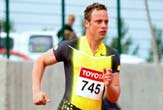Debate Over Artificial Legs in Sports

In an ironic twist, Oscar Pistorius' disability has now been shown to be an unfair advantage. The South African sprinter, who races with two prosthetic lower legs, has been the subject of a see-saw legal battle trying to determine if his carbon fiber, crescent-shaped manufactured legs give him an unfair advantage. Now, two sports scientists have published new research showing that the legs, known as "Cheetahs," make him 15-20 percent faster, equal to 10 seconds over a 400 meter race, then he otherwise would be with natural legs. In 2008, the Court of Arbitration for Sport (CAS) overturned a competition ban placed on Pistorius from the International Association of Athletics Federations (IAAF), track and field's governing body. Seven scientists produced research that refuted the IAAF's contentions and Pistorius was cleared in time to try for a spot on the Beijing Olympic squad. He just missed making that team by .7 seconds, but is now training for the 2012 London games. He did go on the win three gold medals in the 2008 Paralympics. Pistorius, known as the Blade Runner, was born without fibula bones in his lower legs, resulting in a double amputation at the age of 11 months. At age 18, he won the 200m race at the 2004 Summer Paralympics, followed by a gold medal in the 2005 South African championships against able-bodied competitors. Of course, when the discussion is about steroids, blood doping or even corked bats, the athlete becomes the villian. For the "fastest man on no legs," as Pistorius is often called, there are mixed opinions, ranging from those that champion the rights and progress of disabled athletes to those that want to preserve the perceived "level playing field" and integrity of the sport. Supporting the CAS appeal, seven scientists showed that the IAAF's research (which held that Pistorius should not compete) was not valid. However, according to two of the scientists, Peter Weyand of Southern Methodist University in Dallas and Matthew Bundle of the University of Wyoming, they were careful not to imply that there was no advantage. "We are pleased to finally be able to go public with conclusions that the publishing process has required us to keep confidential until now. We recognized that the blades provide a major advantage as soon as we analyzed the critical data more than a year and a half ago," said Weyand and Bundle in a statement.
They explain that all of the group's research did not become public at the CAS hearing because, first, the CAS only asked them to refute the earlier research based on different logic and, second, the long timeline of the peer-review process of academic research just now made it possible to publish. Specifically, what Weyand and Bundle found was that the lightweight blades weigh less than half of what a comparable human lower leg would, allowing Pistorius to swing his leg 15.7 percent faster than the average of five former 100m world record holders. They used high-speed motion cameras to compare leg speed and gait. "Even in comparison to those male sprinters with the most extreme adaptations for speed in recorded human history, Oscar Pistorius has limb repositioning times that are literally off the charts," Bundle said. "Usain Bolt is considered somewhat freakish because he outruns his opponents by 2-4 percent. At top speed, Oscar Pistorius repositions his limbs 15 percent more rapidly than six of the most recent world record holders in the 100 meter dash, including Usain Bolt." In addition, because of how the Cheetahs, from Icelandic manufacturer Ossur, position his upper body, he can leave each "foot" on the ground longer, generating more force with each stride. "He repositions his limbs so fast that he doesn't need to get his body back up into the air so high like other sprinters, and that lowers the force he needs to generate," Weyand told Sports Illustrated. "The muscular forces he has to generate are less than half of what an intact sprinter has to generate to go the same speed." Their research was part of a Point-Counterpoint feature in the current online edition of the Journal of Applied Physiology. In the Counterpoint reply, led by Hugh Herr of MIT, the remaining five scientists contend that studying just one double amputee does not provide enough evidence that the Cheetah legs will consistently provide an advantage. "The notion that lightweight prostheses are the only reason for Pistorius' rapid swing times ignores that he has had many years to train and adapt his neuromuscular system to using prostheses," the authors write. The published research should not cause the CAS to reconsider and, as of now, Pistorius is still eligible to compete for a spot in London. He seems to be keeping all of this debate in perspective, "When people ask me what it's like having artificial legs, I reply, 'I don't know. What's it like having real legs?'" He adds, "Some people view themselves as disabled because they have one or two disabilities. But what about the millions and millions of abilities they have?"
Dan Peterson writes about sports science at his site Sports Are 80 Percent Mental. His Science of Sports column appears weekly on LiveScience.
Sign up for the Live Science daily newsletter now
Get the world’s most fascinating discoveries delivered straight to your inbox.









